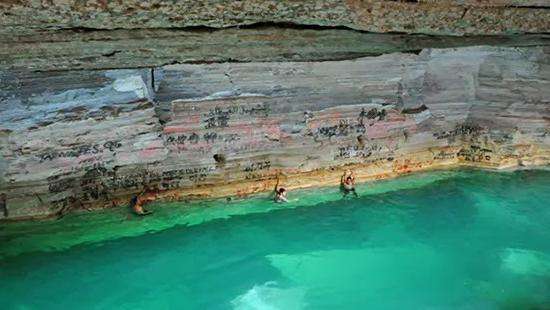April 17, 2015 weblog
Scientists eye YouTube cave videos to track water levels

A spot outside Riyadh for city residents who want to cool off is enabling scientists to do more than enjoy the beauty of their surroundings; they are using YouTube videos to track its rising water levels. Jonathan Amos, BBC science correspondent, reported on Wednesday that scientists are using YouTube graffiti videos (examples of graffiti disappearing beneath rising waters) to track water at the Dahl Hith "spectacular" cave just outside of the Saudi Arabian capital.
The Dahl Hith cave is about 30km SE of Riyadh. Amos said that Dahl Hith is a fascinating site for geologists. "It is one of the few locations where you can see an outcrop of the anhydrite (calcium sulphate) caprock - the seal that traps the Arabian Peninsula's oil," said Amos. Because of abstraction for nearby irrigation, the water levels are rising."The thinking is that the discharge of treated waste water some 10km from the cave is topping up the bathing pool," he said.
Researchers know all this through their documenting cave-wall graffiti, in online movies that were posted by bathers. The researchers used the data to reconstruct past conditions at Dahl Hith. Mary Beth Griggs in Popular Science said that "By looking through the videos for particular graffiti spray painted on the walls in the cave (known as Dahl Hith or Ain Heet), Michelsen could monitor the water levels, looking for how much the water rose over certain graffiti marks over time."
Nils Michelsen, from the Institute for Applied Geosciences, TU Darmstadt, Germany, said in the BBC report that "since there is no other data, you need to be creative."
His study areas include the hydrochemistry and isotope hydrology of arid climate zones "Since smartphones have become so popular and deliver quite good video quality - such data becomes useable. A few years ago, some people would have criticized it as 'grey data', and said 'you shouldn't use it,'" he told the BBC.
Michelsen examined almost 40 YouTube videos made in Dahl Hith. He determined that water levels have risen by about 40cm a month over the past two years and some of his graffiti "benchmarks" have been submerged.
He has presented his team's work at the European Geosciences Union (EGU) General Assembly in Vienna, Austria, from April 12 to April 17. The event covers Earth, planetary and space sciences disciplines.
Amos, meanwhile, placed the cave study in the bigger picture, as another example of a trend - trawling social media for scientifically valuable information, with researchers mining Twitter and other platforms for pictures and keywords. "Another application demonstrated here at EGU," said Amos, "exploits the tweets of Jakarta residents to track the extent of flooding in the Indonesian capital."
© 2015 Phys.org




















